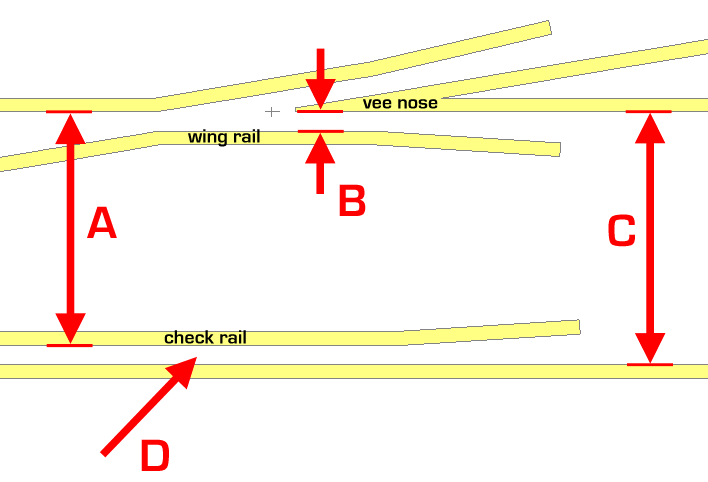It seems to me that Jim is referring to checked curved plain track whilst Martin is talking about the dimension for the all important check gauge at the crossing on a turnout.
Wally
Triangular gauge use in building pointwork.
-
jim s-w

- Posts: 2190
- Joined: Wed Jul 30, 2008 5:56 pm
Re: Triangular gauge use in building pointwork.
Thats right Wally
I know I have deviated from the topic title but when you apply Martins comment 'Nothing ever has a wider check gauge' to check railed curves it doesnt appear that such a piece of track could actually work.
Cheers
Jim
I know I have deviated from the topic title but when you apply Martins comment 'Nothing ever has a wider check gauge' to check railed curves it doesnt appear that such a piece of track could actually work.
Cheers
Jim
-
Martin Wynne

- Posts: 1172
- Joined: Mon May 14, 2012 4:27 pm
Re: Triangular gauge use in building pointwork.
wally wrote:It seems to me that Jim is referring to checked curved plain track whilst Martin is talking about the dimension for the all important check gauge at the crossing on a turnout.
Hi Wally,
The check gauge is the same for both.
On gauge-widened plain track, the check rail flangeway is increased accordingly by the use of special check rail chairs.
Note that the rules require that all curves below 10 chains radius should be fitted with a continuous check rail. They don't necessarily require it to be gauge-widened -- that is left to the p.w. engineer and largely determined by the type of traffic. But if it is widened, the special widened check rail chairs are used.
regards,
Martin.
40+ years developing Templot. Enjoy using Templot? Join Templot Club. Be a Templot supporter.
-
Martin Wynne

- Posts: 1172
- Joined: Mon May 14, 2012 4:27 pm
Re: Triangular gauge use in building pointwork.
jim s-w wrote:when you apply Martins comment 'Nothing ever has a wider check gauge' to check railed curves it doesnt appear that such a piece of track could actually work.
Hi Jim,
I don't understand your problem. If it wasn't important to maintain the check gauge at 4'-6.3/4" in all circumstances, the railway companies would not have gone to the trouble and expense of making special wider check rail chairs for gauge-widened track.
regards,
Martin.
40+ years developing Templot. Enjoy using Templot? Join Templot Club. Be a Templot supporter.
-
jim s-w

- Posts: 2190
- Joined: Wed Jul 30, 2008 5:56 pm
Re: Triangular gauge use in building pointwork.
Its quite Simple
As you say the check gauge is critical so if a check rail is provided on a gauge widened curve (using the wider chairs) then the check gauge has to be widened too otherwise theres no point if the critical dimension stays the same. As you rightly say theres no point doing wider chairs then.
I am not saying thats how it is (because I dont know) just from a logical point of view it doesnt make sense.
Cheers
Jim
As you say the check gauge is critical so if a check rail is provided on a gauge widened curve (using the wider chairs) then the check gauge has to be widened too otherwise theres no point if the critical dimension stays the same. As you rightly say theres no point doing wider chairs then.
I am not saying thats how it is (because I dont know) just from a logical point of view it doesnt make sense.
Cheers
Jim
-
Armchair Modeller
Re: Triangular gauge use in building pointwork.
Martin Wynne wrote:jim s-w wrote:have a wider check gauge to suit.
Hi Jim,
Nothing ever has a wider check gauge. A fixed check gauge is the fundamental requirement:
check gauge A is critical
crossing flangeway B is important
track gauge C shouldn't be less than quoted
check rail flangeway D is don't care
regards,
Martin.
So, on plain track, which would normally only have a check rail on the inside of the curve, the check rail is placed to dimension A from the far running rail (outside of the curve) and the distance from the nearest (inside)running rail can be widened as required by using special chairs, if I understand correctly.
If the distance between the outside of the flange on one wheel and the inside of the flange on the other wheel on an axle is less than dimension A (which I would expect), then the checkrail prevents the wheel set from climbing the outside rail - is that correct?
-
Martin Wynne

- Posts: 1172
- Joined: Mon May 14, 2012 4:27 pm
Re: Triangular gauge use in building pointwork.
Armchair Modeller wrote:So, on plain track, which would normally only have a check rail on the inside of the curve, the check rail is placed to dimension A from the far running rail (outside of the curve) and the distance from the nearest (inside)running rail can be widened as required by using special chairs, if I understand correctly.
Hi AC,
Correct.
If the distance between the outside of the flange on one wheel and the inside of the flange on the other wheel on an axle is less than dimension A (which I would expect), then the check rail prevents the wheel set from climbing the outside rail - is that correct?
Correct.
However, those two dimension are normally the same. Otherwise the check rail would be doing all the work of guiding the wheelset round the curve, leading to excessive wear of the check rail. Often continuous check rails are fitted with flange lubricators for this reason. The normal outer wheel flange should be doing its share of the work of guiding the wheelset, as it is profiled for this purpose to match the rail head.
That's why it is important that the check gauge is maintained constant at the correct dimension -- to match the wheelset "back to effective flange" dimension.
regards,
Martin.
40+ years developing Templot. Enjoy using Templot? Join Templot Club. Be a Templot supporter.
-
Armchair Modeller
Re: Triangular gauge use in building pointwork.
Wow, I really feel I am getting the hang of it now - and here was me thinking that check rails were just for decoration 

I do see a problem though - with curved pointwork. Imagine a point where both roads curve sharply to the left. The right hand road would/could not follow the rules you have described, I think. Even if so, it would be extremely unlikely ever to occur, as the outer road would have to be a much bigger radius than the inner one, I guess.
I do see a problem though - with curved pointwork. Imagine a point where both roads curve sharply to the left. The right hand road would/could not follow the rules you have described, I think. Even if so, it would be extremely unlikely ever to occur, as the outer road would have to be a much bigger radius than the inner one, I guess.
-
grovenor-2685

- Forum Team
- Posts: 3923
- Joined: Sun Jun 29, 2008 8:02 pm
Re: Triangular gauge use in building pointwork.
Imagine a point where both roads curve sharply to the left. The right hand road would/could not follow the rules you have described, I think. Even if so, it would be extremely unlikely ever to occur, as the outer road would have to be a much bigger radius than the inner one, I guess.
Look at enough pictures you will find such occasionally, with the outer road just under 10ch radius it does make the inner pretty tight. But the outer may not be under 10ch as that is just the legal minimum without check rails. Check rails could also be installed on larger radiii if heavy traffic was causing excessive wear.
Regards
Keith
-
Armchair Modeller
Re: Triangular gauge use in building pointwork.
Martin Wynne wrote:Armchair Modeller wrote:If the distance between the outside of the flange on one wheel and the inside of the flange on the other wheel on an axle is less than dimension A (which I would expect), then the check rail prevents the wheel set from climbing the outside rail - is that correct?
Correct.
However, those two dimension are normally the same. Otherwise the check rail would be doing all the work of guiding the wheelset round the curve, leading to excessive wear of the check rail. Often continuous check rails are fitted with flange lubricators for this reason.
Martin.
That is the situation for full scale railways. For models though, would it still be advisable to keep these dimensions the same? I would imagine the extra friction could cause considerable running problems on a long curve.
-
Russ Elliott

- Posts: 930
- Joined: Thu Jun 02, 2011 6:38 pm
Re: Triangular gauge use in building pointwork.
Armchair Modeller wrote:That is the situation for full scale railways. For models though, would it still be advisable to keep these dimensions the same? I would imagine the extra friction could cause considerable running problems on a long curve.
The extra friction should indeed be avoided if possible, so if you do not need functional check rails on plain track, don't set them with a CG! (Exactoscale do 0.8mm check chairs for this very purpose.)
-
Armchair Modeller
Re: Triangular gauge use in building pointwork.
Thanks - that recommendation sounds very sensible. 
I seem to have drifted a long way off the topic though, so sincere apologies again to the OP
I seem to have drifted a long way off the topic though, so sincere apologies again to the OP
Return to “Track and Turnouts”
Who is online
Users browsing this forum: ClaudeBot and 3 guests
